DirtTrailsWanted
Active member
For the longest time, our largest hurdle in living life full-time on the road had been how do we stay connected so that we can work remotely from wherever we are. It used to be that we relied heavily on either a strong cell phone signal or we had to camp close enough to easily go into town to use WiFi for the workday. Those two things greatly limited how far we used to be able to travel during the work week, but not any longer, this is how we manage it now!
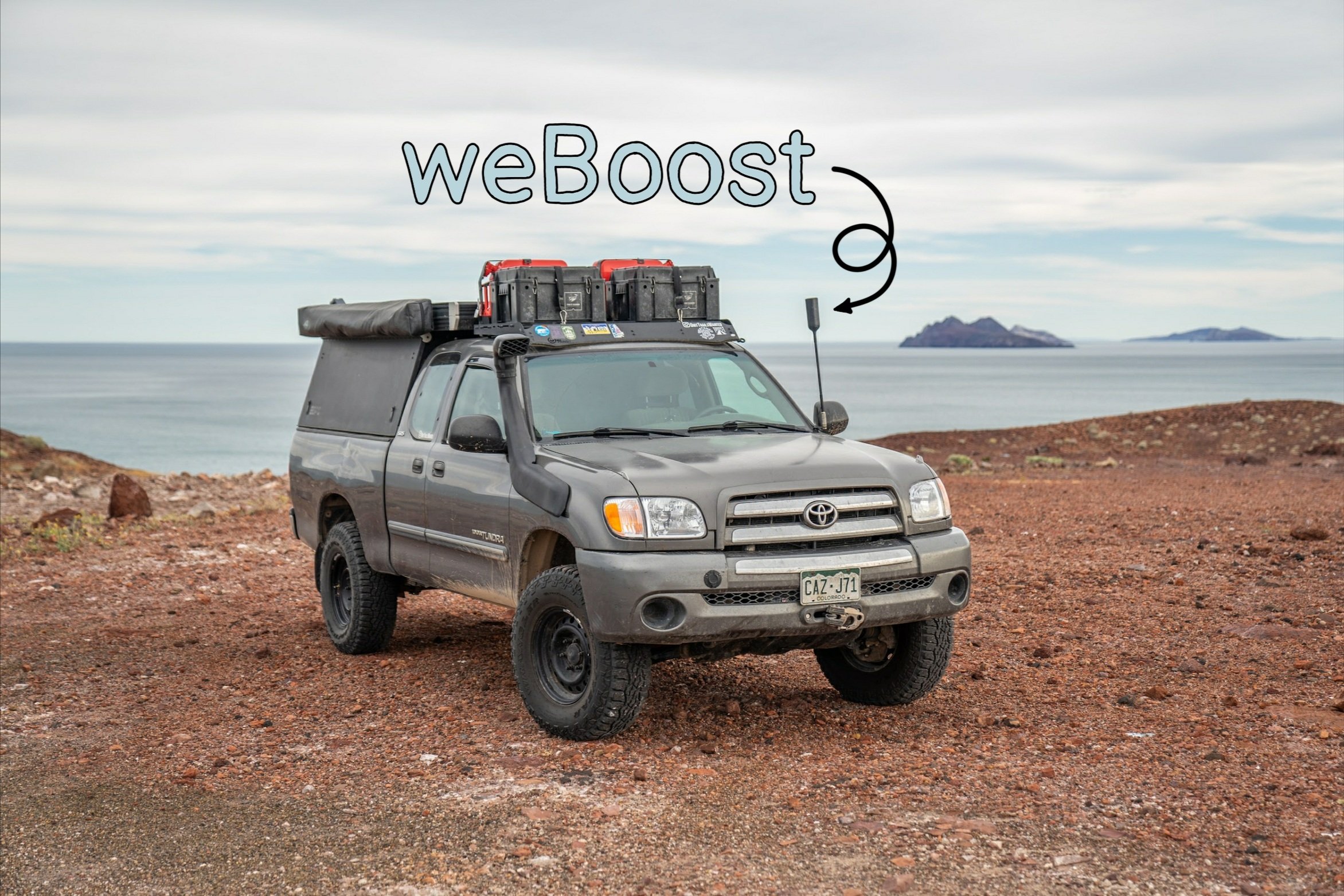
Early on in our travels, we relied heavily on our weBoost Drive Reach RV. This cell phone signal booster has worked great for us, but it’s got one catch. It requires that it is able to pick up some signal in order to boost a weak signal into a stronger more usable signal. We found that it worked great when we were up high on a ridge, or overlooking a town. However, if we were parked in places that had no signal like in a canyon, or on the opposite side of a mountain from a town the booster would not work, simply because there wasn’t any signal to boost. In general we are still really glad to have the weBoost as it’s helped with boosting our cell signal for day-to-day driving so we are less likely to drop a call, and are still able to search Google Maps and other apps. If/when we build another rig, we will likely install another weBoost on that vehicle too.
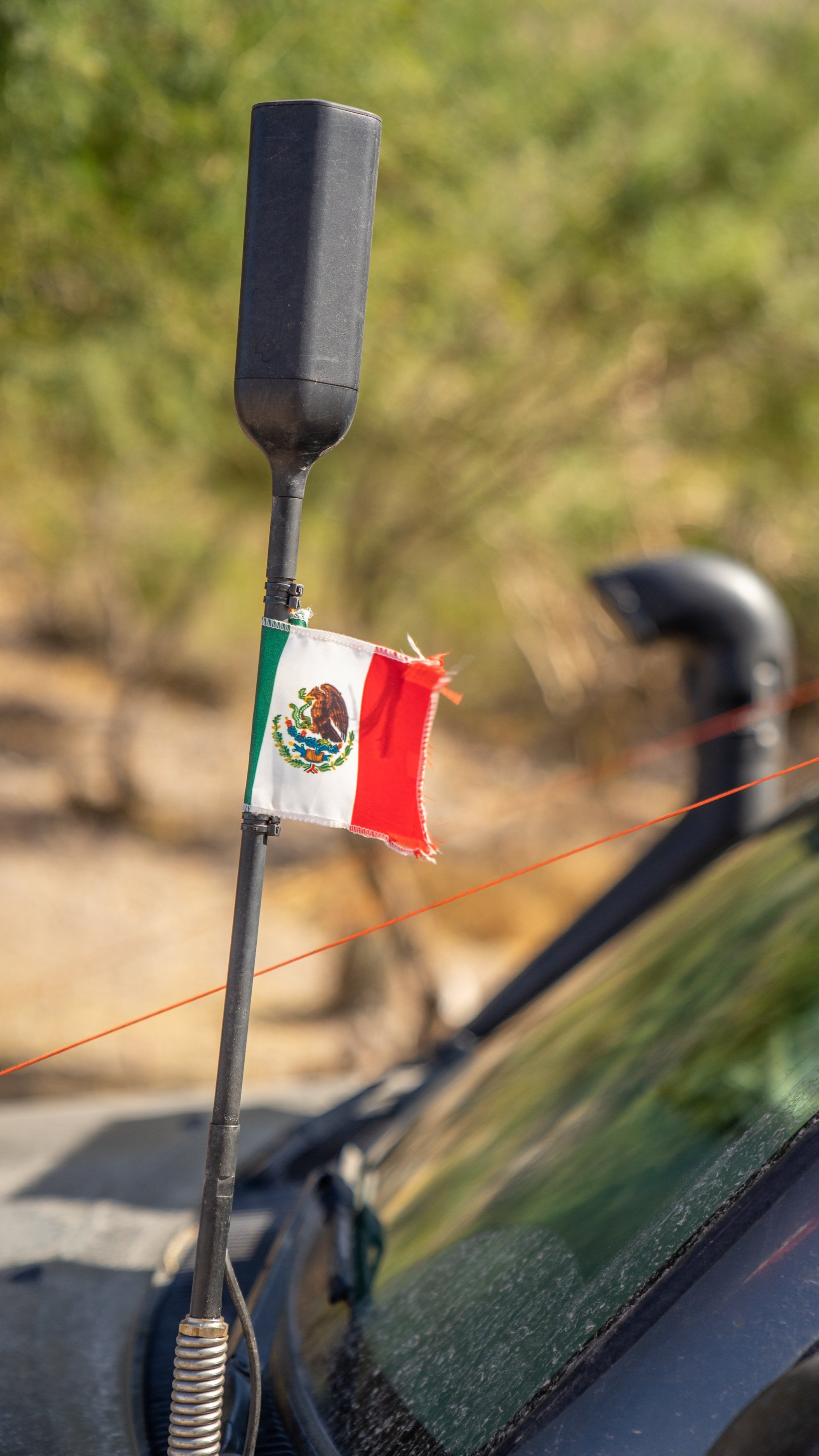
weBoost antenna
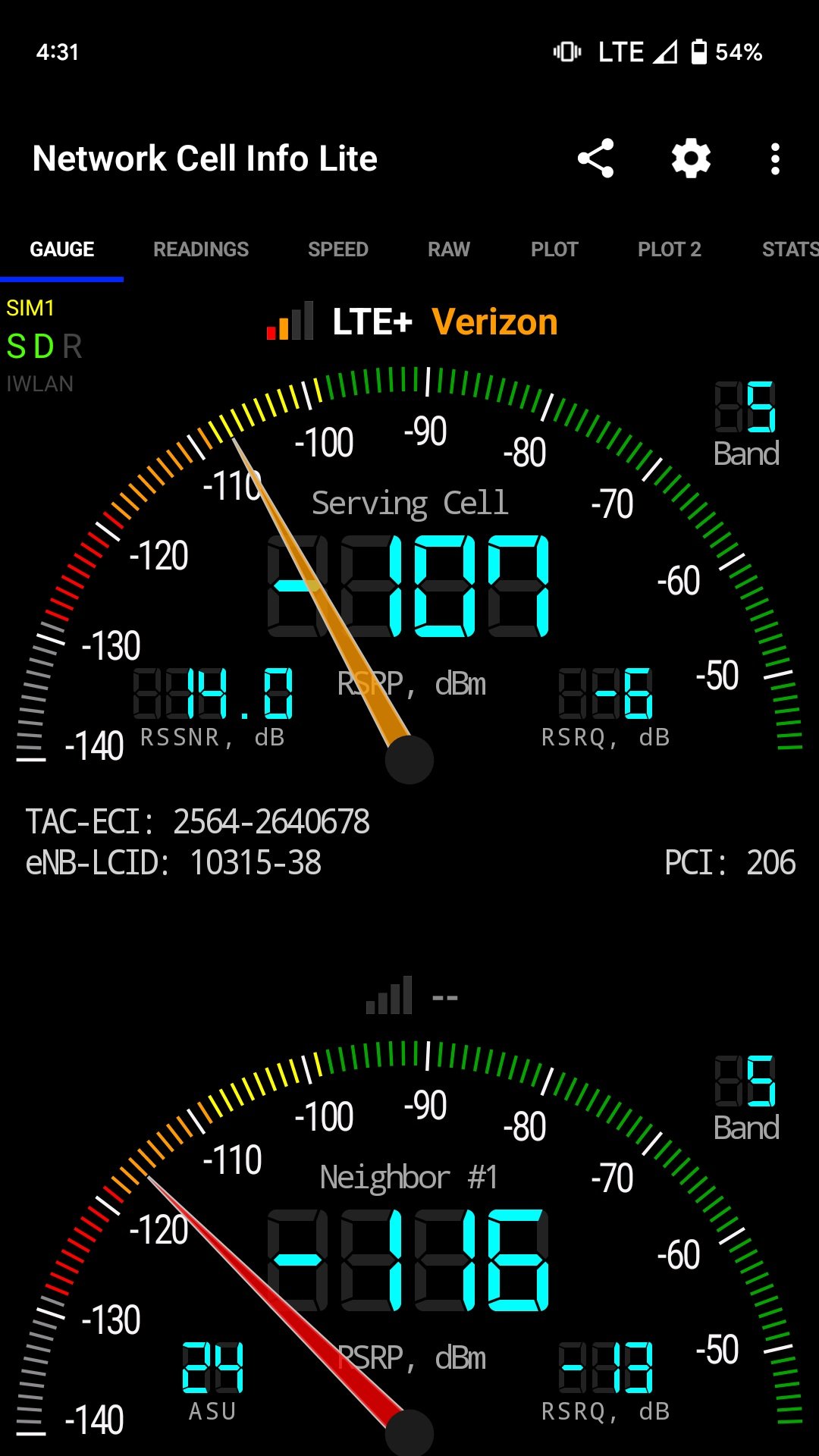
Top shows signal with weBoost off!

Top shows signal with weBoost on!
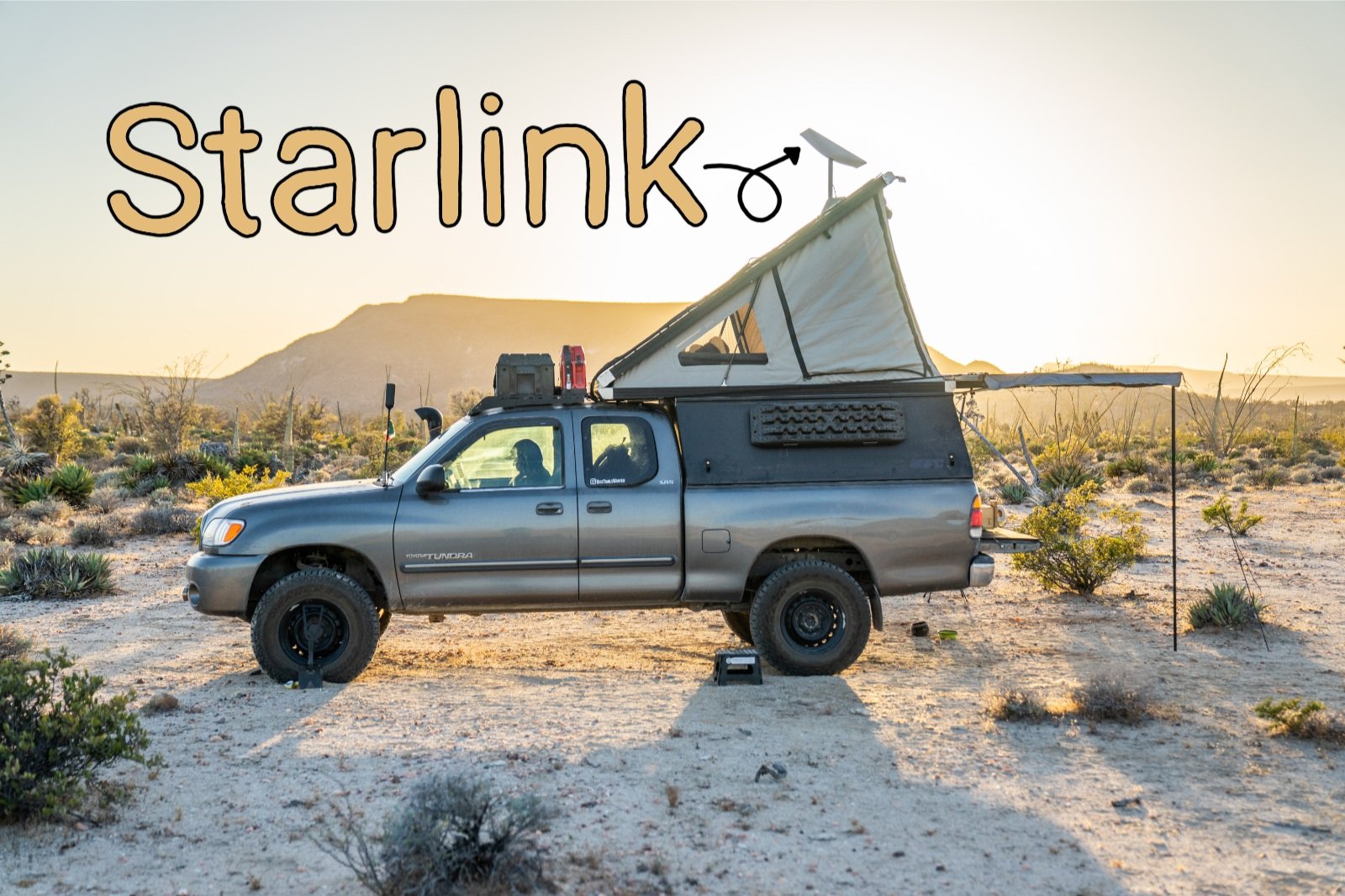
Currently, the communication system that we rely on most heavily is our SpaceX Starlink. We have now been using Starlink as our main means of FAST, reliable mobile internet from anywhere we are for over a year. And when we say anywhere, we truly mean it! Their coverage map shows that all of North America is covered along with the vast majority of South America and many other countries across the rest of the world.
The catch here is that you have to have a clear view of the sky since it’s a satellite-based internet service. We have found that for the most part that view needs to be to the north but when we were far north in Canada last summer the dish pointed itself south. Finding a clear view of the sky hasn’t proved to be much of an issue for us since we generally find ourselves roaming around the wide-open western half of the United States but I could imagine in the more tree-covered parts of the world this can pose some problems.
Starlink sells several dish options but the one we are using is their residential dish with their ‘Roam’ plan, which allows us to move around with service, and pause service whenever we would like. Currently, we have our Starlink set up so that we mount the dish on the back of our camper when we are in camp. Having it there helps to get it higher above any potential obstructions that would block the view of the sky, as well as protecting it from getting hit or knocked over on the ground.
Starlink also sells a pricey flat mount dish labeled as ‘Mobility’ that is intended to be mounted on a vehicle allowing you to have internet while on the move. Another option is to adapt the residential dish into a flat-mount option. There are several companies offering this as a service or as a DIY kit, Starmount seems to be the most popular, and I think combining that with converting it over to 12volt has some really cool potential for a lot of people. Here is a list of parts needed to go to 12volt. We have chosen to not go that route since it makes it so much easier to turn the internet on. We kinda like that it takes us a few moments to set ours up so that on the weekends when we want to disconnect it’s a bit less tempting to just switch the internet on.
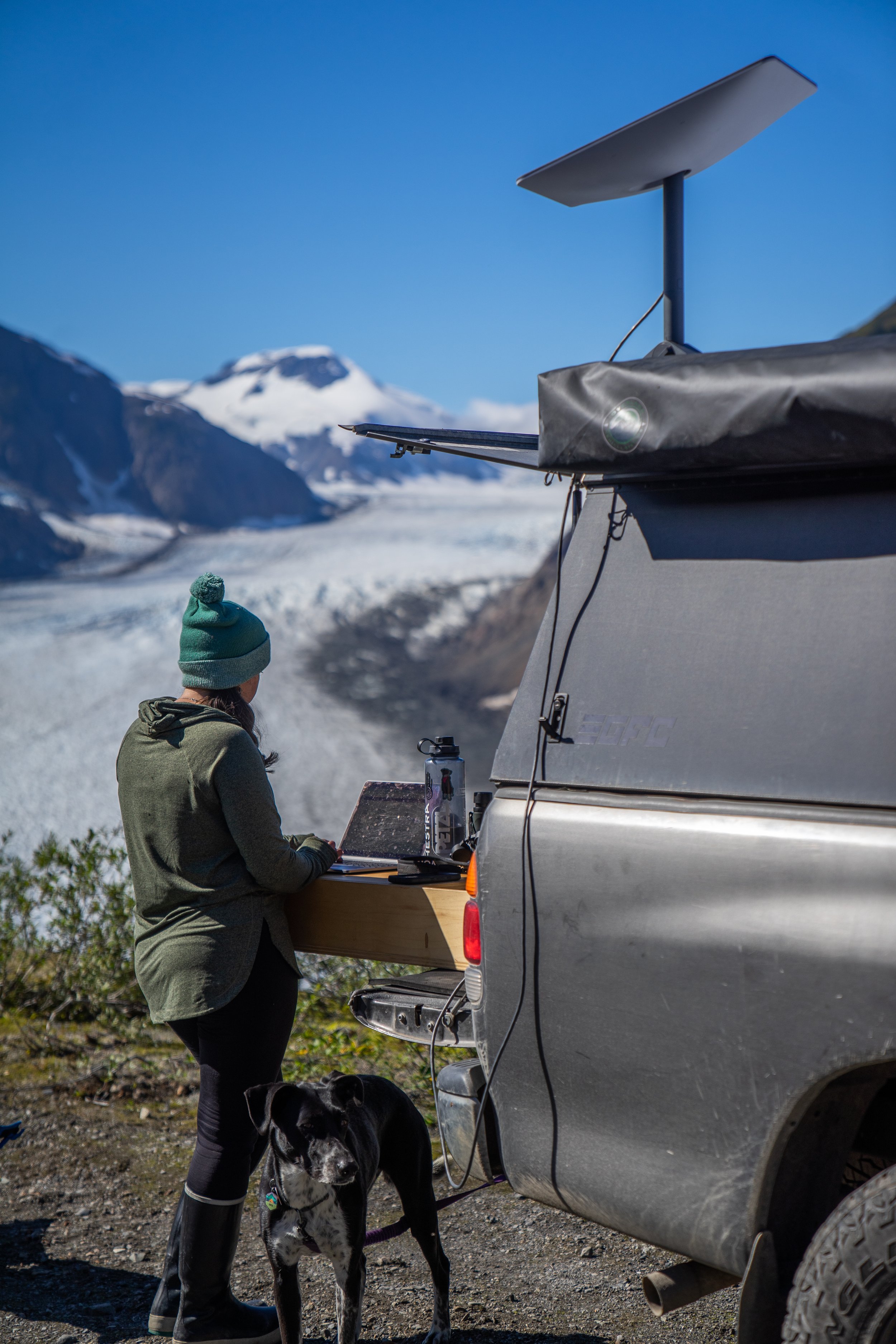

All of the things above are pretty vehicle-based systems, so let’s chat about what we use when we are away from the truck.
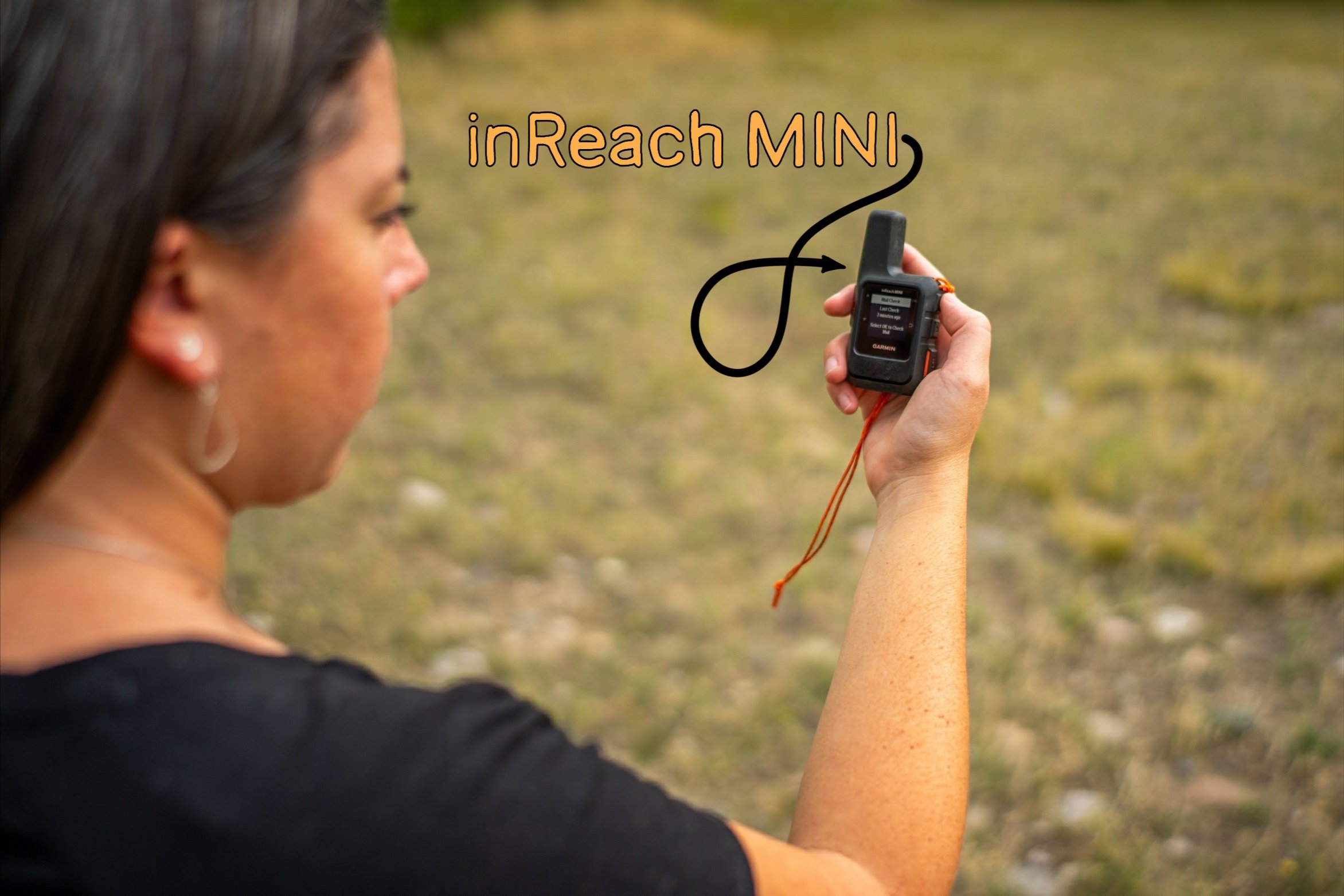
The one device that travels nearly everywhere with us, and is in quick reach even inside the truck is our Garmin inReach Mini. This again is a satellite-based system, however, it’s really only meant to be used in emergencies or for short text or email-based communications, not for working. Garmin offers several subscription-based services with this, and like Starlink, it requires a view of the sky to work, though it’s less picky about how obstructed that view this. This works globally and is able to send out either SOS signals to alert local emergency services, or you can send short messages to contacts. We have found that it works great if we want to share our camp location with friends who might be coming to join us or to update people that you are running late from an area that has no cell signal. We still use this in situations where setting up Starlink would be too time-consuming. We really love how small the inReach mini is and how easy it is to bring with us if we are out for a hike or something and are away from the truck.
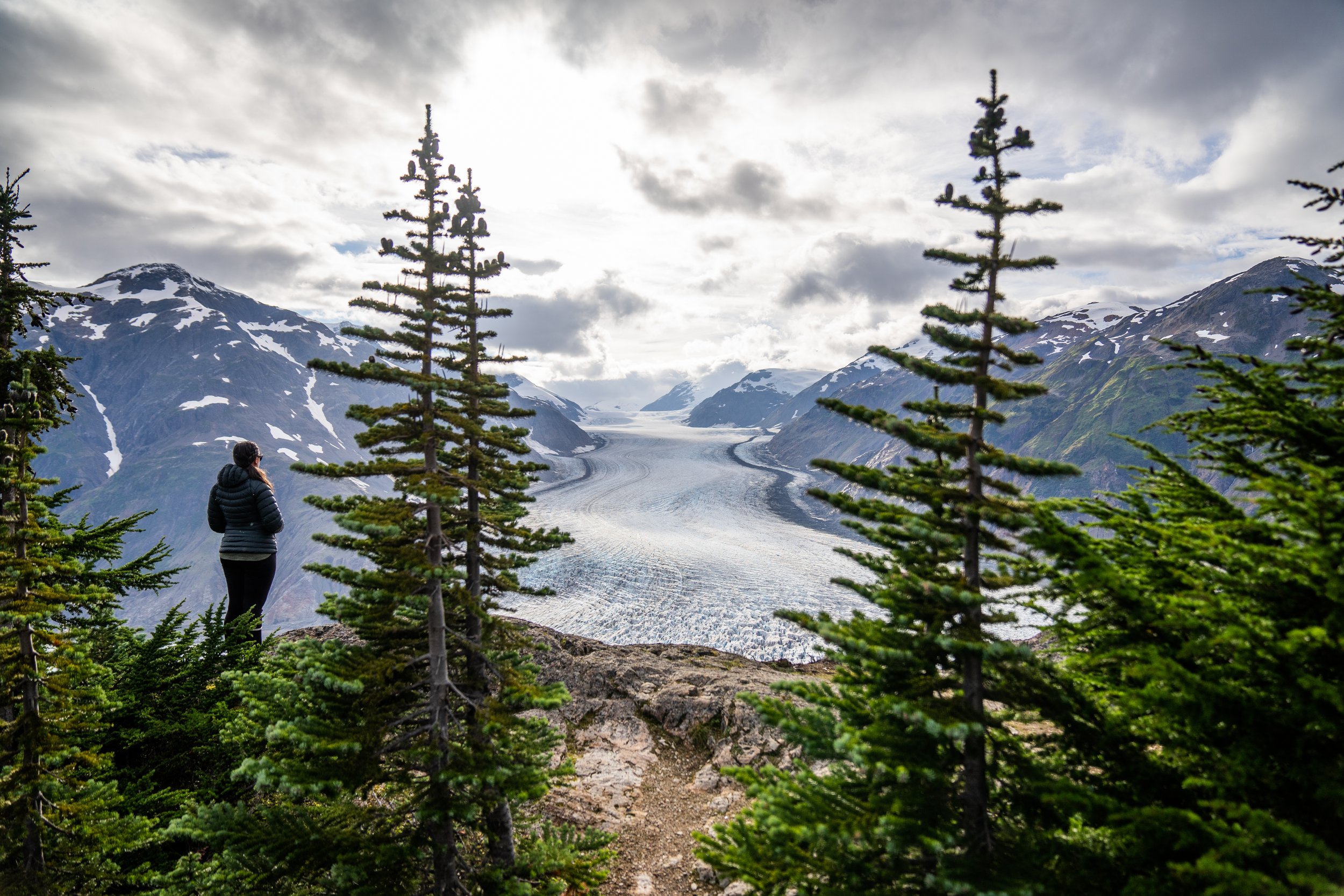
So far all of the things that we have talked about help us communicate far and wide, but what about communicating locally, for example between two or more vehicles while traveling out of cell signal?

For that, we recently switched from store-bought walkie-talkies to a set of BAOFENG UV-5X GRMS RADIOS and a single BAOFENG UV-5R 8W HAM RADIO. With these, we are able to utilize a boarder range of communication than we were able to with the walkie-talkies and also able to communicate much further distances as well. Since these radios transmit on GMRS you’ll need to purchase a GRMS license from the FCC, which you can get for $35 without needing to take a test. If you intend to transmit on the HAM frequencies you’ll have to get a HAM radio license for $35 to the FCC again but you'll also have to pass a test for this. The test isn’t overly challenging, and most people can pass it within a week of study. One of the largest benefits to having a set of radios with you is when traveling with a group, it makes it so much easier to communicate things like stops for fuel, food, or photos, or to point out a beautiful landmark that maybe someone might miss, and being about to communicate that to the group as a whole instantaneously. The size of the radios also works well to carry with groups when out hiking or traveling away from the vehicle since they are small enough to drop into a pocket or get clipped to a backpack strap. After purchasing these we also realized that they have a lot of other fun applications like listening to the International Space Station as it passes overhead, and even attempting to make contact with them.
Here is some information on getting your GMRS license
Here is a great study resource for getting your Ham license
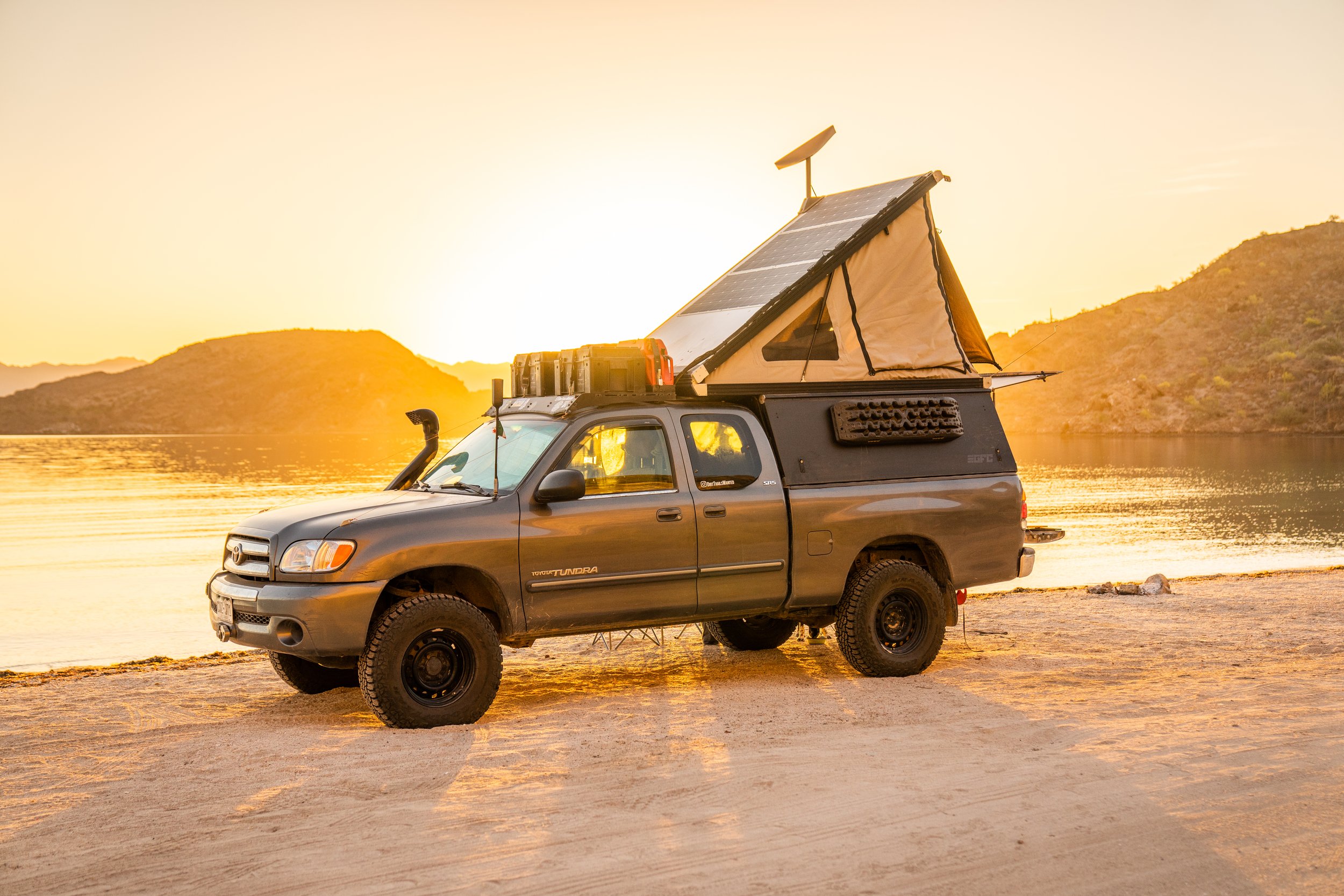
One of the things we have learned over our years of traveling, and adventuring is that redundancy in your systems is important. We have set ourselves up to have several backup means of communication in the event that maybe one system fails, or is down for a short period of time, it’s nice to have a safety net in place to help fill in the gaps.
If you're curious about how we power all this, here is a link to the electrical setup in our truck.

Early on in our travels, we relied heavily on our weBoost Drive Reach RV. This cell phone signal booster has worked great for us, but it’s got one catch. It requires that it is able to pick up some signal in order to boost a weak signal into a stronger more usable signal. We found that it worked great when we were up high on a ridge, or overlooking a town. However, if we were parked in places that had no signal like in a canyon, or on the opposite side of a mountain from a town the booster would not work, simply because there wasn’t any signal to boost. In general we are still really glad to have the weBoost as it’s helped with boosting our cell signal for day-to-day driving so we are less likely to drop a call, and are still able to search Google Maps and other apps. If/when we build another rig, we will likely install another weBoost on that vehicle too.

weBoost antenna

Top shows signal with weBoost off!

Top shows signal with weBoost on!

Currently, the communication system that we rely on most heavily is our SpaceX Starlink. We have now been using Starlink as our main means of FAST, reliable mobile internet from anywhere we are for over a year. And when we say anywhere, we truly mean it! Their coverage map shows that all of North America is covered along with the vast majority of South America and many other countries across the rest of the world.
The catch here is that you have to have a clear view of the sky since it’s a satellite-based internet service. We have found that for the most part that view needs to be to the north but when we were far north in Canada last summer the dish pointed itself south. Finding a clear view of the sky hasn’t proved to be much of an issue for us since we generally find ourselves roaming around the wide-open western half of the United States but I could imagine in the more tree-covered parts of the world this can pose some problems.
Starlink sells several dish options but the one we are using is their residential dish with their ‘Roam’ plan, which allows us to move around with service, and pause service whenever we would like. Currently, we have our Starlink set up so that we mount the dish on the back of our camper when we are in camp. Having it there helps to get it higher above any potential obstructions that would block the view of the sky, as well as protecting it from getting hit or knocked over on the ground.
Starlink also sells a pricey flat mount dish labeled as ‘Mobility’ that is intended to be mounted on a vehicle allowing you to have internet while on the move. Another option is to adapt the residential dish into a flat-mount option. There are several companies offering this as a service or as a DIY kit, Starmount seems to be the most popular, and I think combining that with converting it over to 12volt has some really cool potential for a lot of people. Here is a list of parts needed to go to 12volt. We have chosen to not go that route since it makes it so much easier to turn the internet on. We kinda like that it takes us a few moments to set ours up so that on the weekends when we want to disconnect it’s a bit less tempting to just switch the internet on.


All of the things above are pretty vehicle-based systems, so let’s chat about what we use when we are away from the truck.

The one device that travels nearly everywhere with us, and is in quick reach even inside the truck is our Garmin inReach Mini. This again is a satellite-based system, however, it’s really only meant to be used in emergencies or for short text or email-based communications, not for working. Garmin offers several subscription-based services with this, and like Starlink, it requires a view of the sky to work, though it’s less picky about how obstructed that view this. This works globally and is able to send out either SOS signals to alert local emergency services, or you can send short messages to contacts. We have found that it works great if we want to share our camp location with friends who might be coming to join us or to update people that you are running late from an area that has no cell signal. We still use this in situations where setting up Starlink would be too time-consuming. We really love how small the inReach mini is and how easy it is to bring with us if we are out for a hike or something and are away from the truck.

So far all of the things that we have talked about help us communicate far and wide, but what about communicating locally, for example between two or more vehicles while traveling out of cell signal?

For that, we recently switched from store-bought walkie-talkies to a set of BAOFENG UV-5X GRMS RADIOS and a single BAOFENG UV-5R 8W HAM RADIO. With these, we are able to utilize a boarder range of communication than we were able to with the walkie-talkies and also able to communicate much further distances as well. Since these radios transmit on GMRS you’ll need to purchase a GRMS license from the FCC, which you can get for $35 without needing to take a test. If you intend to transmit on the HAM frequencies you’ll have to get a HAM radio license for $35 to the FCC again but you'll also have to pass a test for this. The test isn’t overly challenging, and most people can pass it within a week of study. One of the largest benefits to having a set of radios with you is when traveling with a group, it makes it so much easier to communicate things like stops for fuel, food, or photos, or to point out a beautiful landmark that maybe someone might miss, and being about to communicate that to the group as a whole instantaneously. The size of the radios also works well to carry with groups when out hiking or traveling away from the vehicle since they are small enough to drop into a pocket or get clipped to a backpack strap. After purchasing these we also realized that they have a lot of other fun applications like listening to the International Space Station as it passes overhead, and even attempting to make contact with them.
Here is some information on getting your GMRS license
Here is a great study resource for getting your Ham license

One of the things we have learned over our years of traveling, and adventuring is that redundancy in your systems is important. We have set ourselves up to have several backup means of communication in the event that maybe one system fails, or is down for a short period of time, it’s nice to have a safety net in place to help fill in the gaps.
If you're curious about how we power all this, here is a link to the electrical setup in our truck.
